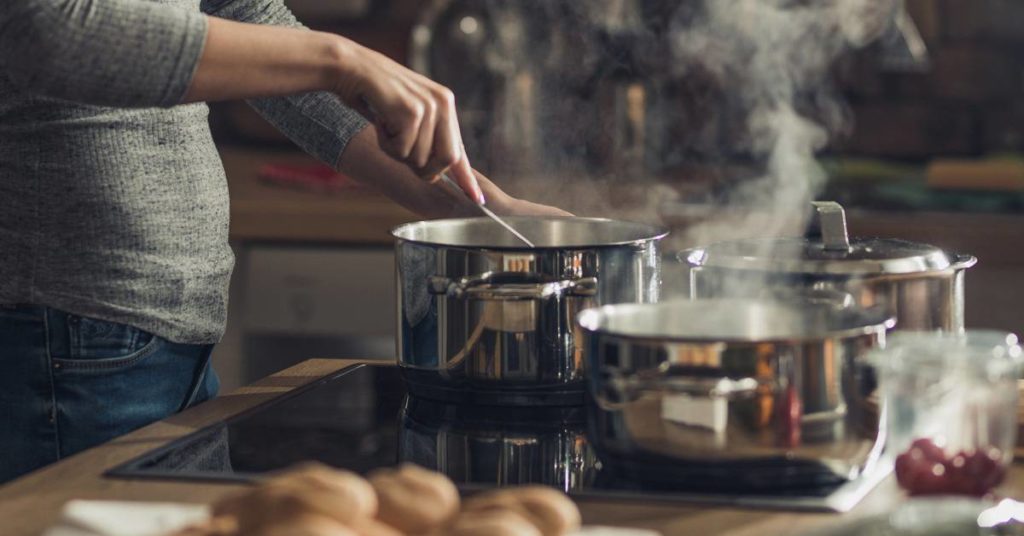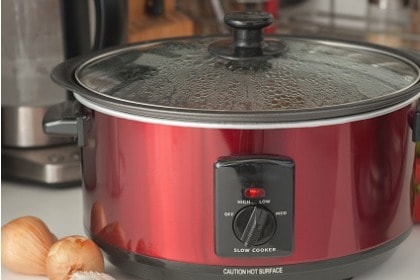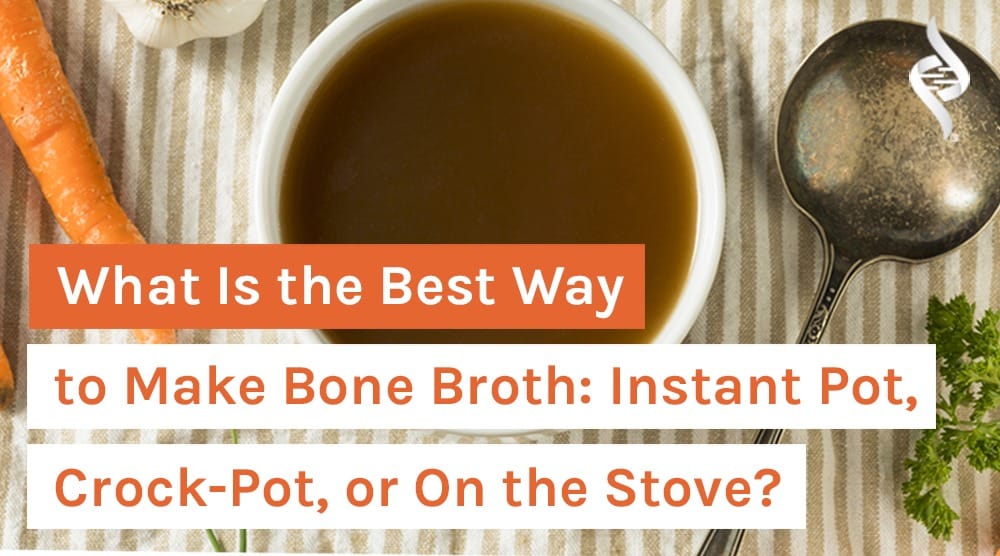What Is the Best Way to Make Bone Broth: Instant Pot, Crock-Pot, or On the Stove?
In a hurry? Click here to read the Article Summary...
“I will recommend broths for people who are experiencing electrolyte imbalances, especially after vomiting, diarrhea, or excessive sweating. For people on liquid diets, bone broth may make them feel like they’re getting a little bit more variety.”
L.J. Amaral, clinical dietitian, Samuel Oschin Comprehensive Cancer Institute
Are you a fan of making bone broth? The traditional method is to simmer bones on the stove for many hours. But what about using cooking appliances that may be a little easier or require less time. Can they be used to make bone broth? Read on to learn the pros and cons of making bone broth in an Instant Pot (pressure cooker), a Crock-Pot (slow cooker), and the “old-fashioned” way by using a pot on the stove.
Choose Your Pot Carefully
Bone broth is traditionally made by boiling bones for a long time. Chicken, beef, lamb, game, or even fish bones can be used to make bone broth. Vegetables like celery, onion, and carrot can be added, or the bones can just be boiled solo. (If you need a quick refresher on how to make bone broth at home the traditional way, read this article.)

The thing that sets bone broth apart from other broths and stocks is the long boiling time that breaks down hard bones and extracts the amino acid-rich marrow from inside them.
Unfortunately, all cooking containers have the potential to be made from toxic materials. Regular pots are sometimes made from aluminum and some slow cookers still contain lead inside the ceramic seal. Even a few of the older models of the Instant Pot, a popular brand of pressure cooker, have been shown to contain trace amounts of lead and cadmium in the outer area [1].
No matter which cooking method you choose, make sure that your pot is made of either:
- stainless steel
- cast iron
- ceramic
- enameled cast iron
Never use Teflon, aluminum, or a pot that is too old or scratched as the chances of harmful toxic metals leaching into your broth will be high with these products.
Choose a broth-making container that has been tested and is free from all harmful chemicals and heavy metals, no matter which cooking method you choose.
Making Bone Broth in a Pressure Cooker or “Instant Cooker”
“I always make my broth in a pressure cooker, simply because it is the quickest way to do it. Originally, I simmered a large stockpot on the stove for a couple of days straight, but I didn’t sleep well knowing the stove was on. Also, more often than not my broth would not gel when cooled—a sign of the concentration of gelatin in the stock, which we look for due to its gut-healing properties.”
Mickey Trescott, Autoimmune Protocol
An instant cooker, better known by the Canadian brand name Instant Pot, can do a lot of things including make yogurt. For the purposes of preparing bone broth in a fraction of the time, however, its use as a pressure cooker is what we’re interested in.
Pressure cookers work by expelling air from the inside of the vessel and trapping the steam inside along with the boiling liquid.
Bone Broth Pressure Cooker Pros
The high heat and pressure created inside the pot allow food to be cooked far quicker than any other method.

Of course, the biggest “pro” to using an Instant Pot or pressure cooker for your bone broth is that you can make it in as little as two to three hours. Another big plus is that it is truly a “set it and forget it” operation.
You don’t have to worry about a pot boiling over on the stove, forgetting to turn off the burner, or adding extra water because of off steaming. A few hours later, you get to come back and enjoy your broth. That’s it!
Many people also claim that chicken, beef, or other kinds of bone broth prepared in a pressure cooker creates more consistent results. In the “bone broth world” that means more consistent “gelling” after it cools.
Consistency with the Instant Pot also includes the amount of broth made, since how much water you put in is pretty much the amount of broth you are going to get. Of course, there is also little chance of burning with a pressure cooker.
Bone Broth Pressure Cooker Cons
All that being said, there are some cons to making bone broth in an Instant Pot. For one thing, you will not be able to make as much broth as you could if you used a regular pot or crockpot.
Most pressure cookers hold around 8 quarts. That won’t necessarily yield you 8 quarts of broth, however, because you need to leave room at the top for the steam to gather. Likewise, because of the small size, Instant Pots aren’t the greatest if you have large bones to work with.
If you choose to use a pressure cooker for making bone broth, make sure to use just the right amount of ingredients for the container. Crowding means you won’t have as nutrient-rich of a broth as you would if you would have left some “breathing” room.
Making Bone Broth in a Slow Cooker or Crock-Pot
“Bone broth touts a lot of benefits. You can sip it by the mugful, as a warm, savory and very nutrient-dense drink. Or you can use this immune-supportive broth to replace chicken or beef broth in your cooking. Make it at home in a slow cooker over 12 to 24 hours. Then, you can batch and freeze portions for future uses.”
Cleveland Clinic, Slow Cooker Bone Broth
Crock pots have been around for generations and can be used for anything from stews to casseroles. But how do they fare for making bone broth?
Crock Pot Bone Broth Pros

Although they are not as handy as Instant Pots, slow cookers for bone broth are great if you want to make large quantities or you are using large bones.
Like cooking with a pressure cooker, there is not much “babysitting” needed with this method and adjustment in temperature is not usually required either. In fact, many people simply put their slow cooker on “low” and let their broth cook throughout the night.
Crock Pot Bone Broth Cons
Now to the cons regarding crock pots. The first one is pretty obvious if you have a small kitchen. Even the smaller-sized crock pots take up a lot of counter space, and all of them need to be near a plug.
Another con regarding crock pots is loss of liquid. Steam inevitably escapes over the hours, even if you have a secure lid. For that reason, it’s a good idea to check your broth at least a couple of times during the course of the day if you have your bone broth slow cooker temperature set on anything other than “low.”
The result of loss of liquid can be either a less gelatinous, more diluted broth (because of added water) or a bitter broth because of overcooking. The potential for either overcooking or burning are two other downsides of making bone broth in slow cookers.
One final note is that some Crock-Pots will automatically turn off after a set number of hours (e.g., after 6, 8, or 10 hours). As bone broth often takes longer than that you will need to be around to start the slow cooker up again.
Bone Broth in a Regular Pot (aka The “Traditional” Way)
“Bone broth contains a number of healthy and beneficial nutrients. It may have anti-inflammatory effects, can help improve bone and joint health, and may improve sleep quality.”
Healthline, Why You Should Make Bone Broth
Bone broth made in a regular pot is the “tried and true” way of doing it and has been the go-to method for literally thousands of years. Cooking bone broth on the stovetop (or over an open flame for our ancestors) is a great choice if you want to control how long you cook it, if you plan on adding things into the broth throughout the day, and if you know you’re planning to be at home all day to keep can keep an eye on it.
Another “pro” when it comes to cooking with a pot on the stove is you get to decide how much you want to make depending on the size of the pot you use. You also have control over the temperature and can adjust it as needed.

As a side note, most pot-on-the-stove users say that gas stoves are more reliable then electric stoves in terms of consistency. Also, the heavier the bottom of your pot is, the better the heat distribution will be for your broth overall.
The downside of the pot-on-the-stove method is that your pot will most definitely need to be “babysat” to keep from boiling dry since this method inevitably leads to loss of liquid. Leaving the stove on overnight comes with its own potential hazards and good safety practices need to be followed.
One final note about cast iron pots. Keep in mind that because you will be boiling your broth for so long in this kind of container, the iron content in your bone broth will be higher than if you use a pot made of a different material.
Bone broth already contains a certain amount of iron, along with other essential minerals. Using an iron pot will kick that amount up quite significantly. One study in the Journal of the American Dietetic Association found that iron content rose from 0.6 mg to 5.7 mg after spaghetti was cooked in a cast-iron pot [2]. This is a potential concern for certain individuals who wish to avoid iron toxicity [3].
Bone Broth the Easy Way
If you want to cut out the hassle altogether, one super easy option is to take advantage of 100% organic, non-GMO, allergen-free Organixx Bone Broth Protein powder. All you need to do is add a scoop, blend with your favorite beverage, and serve. No pot of any kind needed!
Organixx Clean Sourced Collagens blend contains five types of collagen from four sources. What’s more, it’s combined with targeted nutrients such as zinc, vitamin C, and vitamin B6 which specifically enhance the bioavailability and potency of collagen. Clean Sourced Collagens is formulated from the ground up to enhance and support your body’s natural ability to heal and rebuild itself from the INSIDE out.

 Sources:
Sources:
Article Summary
The traditional way to make bone broth is in a pot on top of the stove (or an open fire for our ancestors). But there are new ways including using an Instant Pot (pressure cooker) and Crockpot (slow cooker).
-
No matter which cooking method you choose, make sure that your pot is made of non-toxic materials:
- stainless steel
- cast iron
- ceramic
- enameled cast iron
The high heat and pressure created inside a pressure cooker allow food to be cooked far quicker than any other method. The downside of making bone broth in an Instant Pot is the smaller volume of broth that can be prepared at one time.
Slow cookers for bone broth are generally good if you want to make large quantities of broth or you are using large bones. The downside is the potential loss of steam and the counter space required.
Cooking bone broth on the stovetop is a great choice if you want to control how long you cook it, if you plan on adding things into the broth throughout the day, and if you know you’re planning to be at home all day to keep can keep an eye on it.
To eliminate any hassle of cooking bone broth, you can use powdered bone broth such as Organixx Bone Broth Protein powder. No pot required!





This is all new to me. Even though I have an Instant Pot I believe I will try the on the stove top method. This article was very helpful and I may cook it both ways later if I need to speed up the cooking since 2 of us will be drinking it. I have a question do you wait until an hour before it is through to add vegetables and then blend them in? Or take them out because they served their purpose and are over cooked?
Hi Tina, thanks for your comment. Glad to hear that you'll be giving this a try.
You can actually add the vegetables right in the beginning and add some additional vegetables and/or seasonings 1-2 hours before finishing.
We actually have an article that goes through the steps of making traditional healing bone broth from home. Feel free to check it out here: https://organixx.com/how-to-make-bone-broth/
But please, feel free to add your own twist to your bone broth recipe by using your preferred ingredients. We love it when our friends get creative!
We hope you find this helpful and wish you a happy & healthy day!
I do prefer to make bone marrow broth with grass fed cow bones. I use an instant pot or slow cooker and add apple cider vinegar for 30' before heating the bones. After 48 hrs. or more I add a handful of parsley and cook 10'. I strain the broth and freeze in small jars or silicon baking cups. I take the marrow and freeze separately. When I cook with the broth I add Organixx powder!
Excelente artículo sobre el caldo de huesos muy explícito se merecen nuestro reconocimiento y felicitarlos
This is a great idea of make bone broth!
I have a big Presser cooker from Germany, and it goes with nutrition and value when used a pressure cooker....
some people think that it ;loses the nutrition with high pressure...
I usually let it collect the pressure and when the bitten comes up either reduce the heat , and
sometimes clause the heat, and open when the the pressure is gone...
I remember from some summits, that they tested after cooking in pressure cooker, and it did not loose
the value.